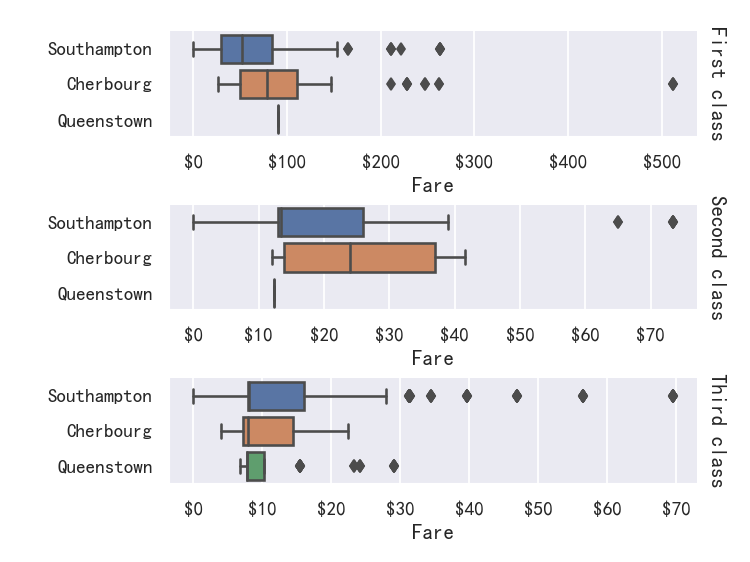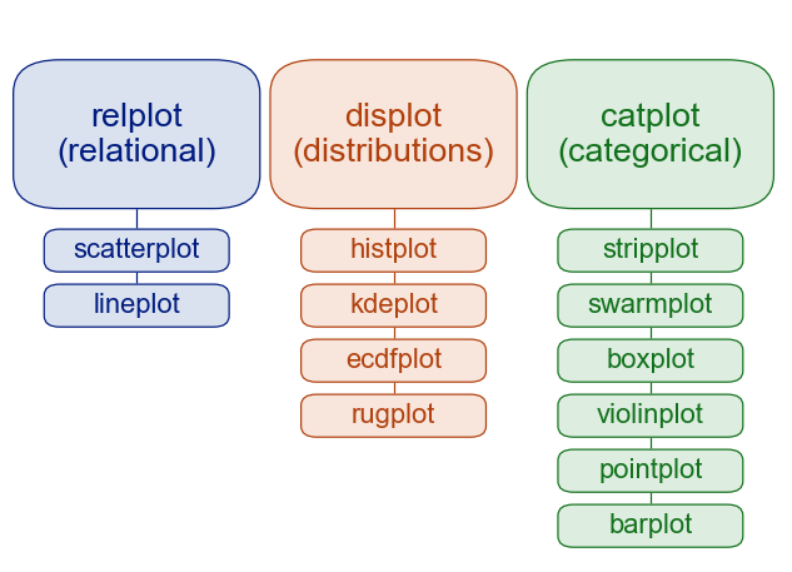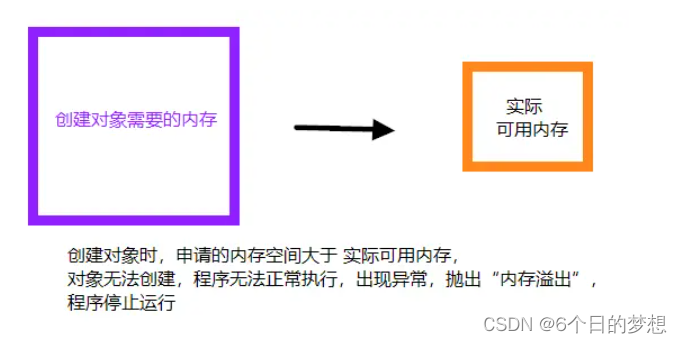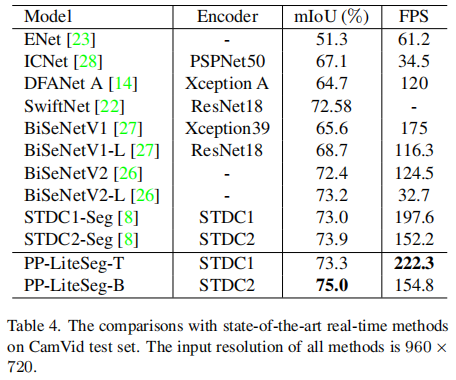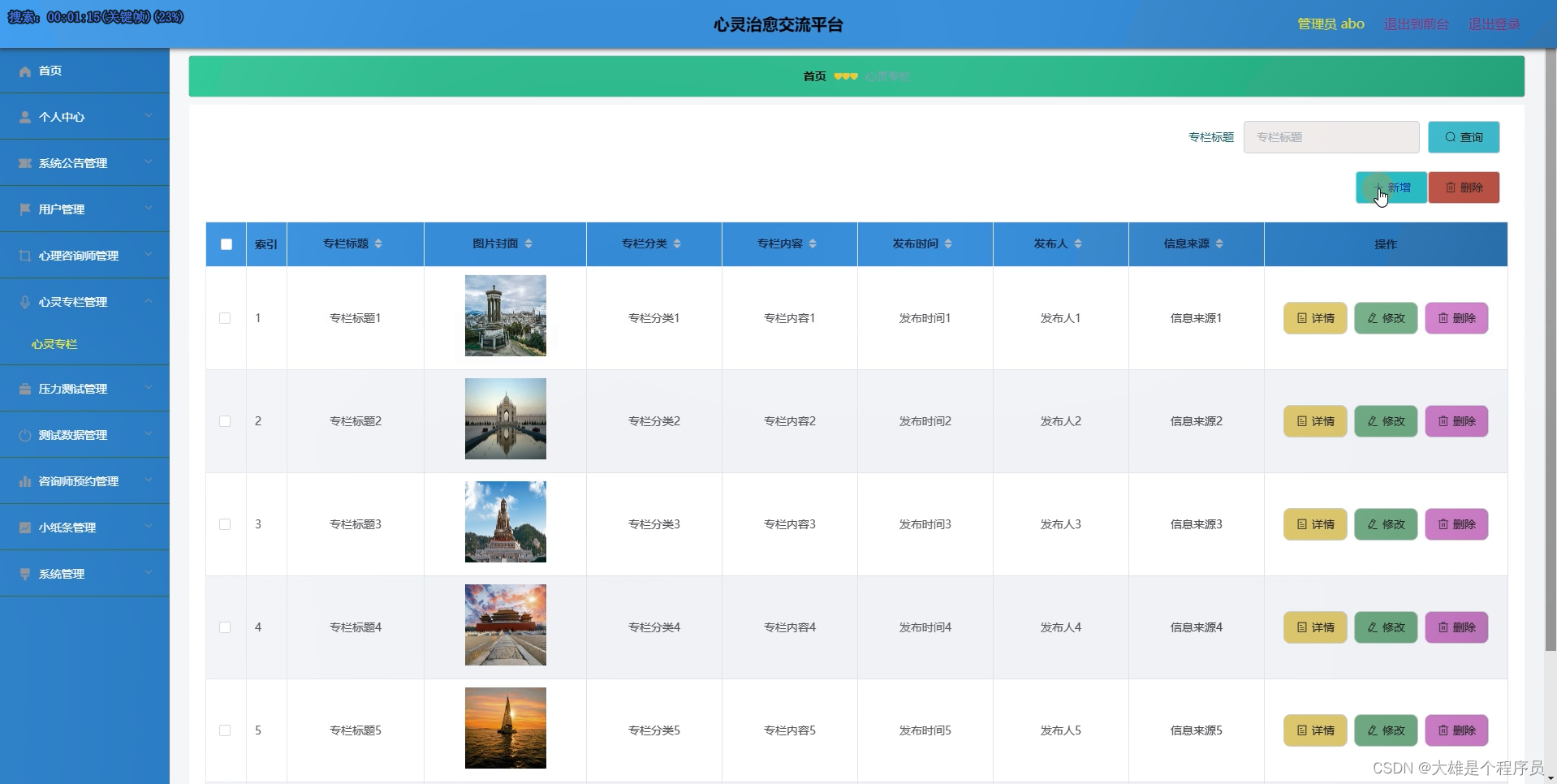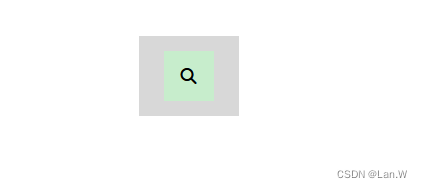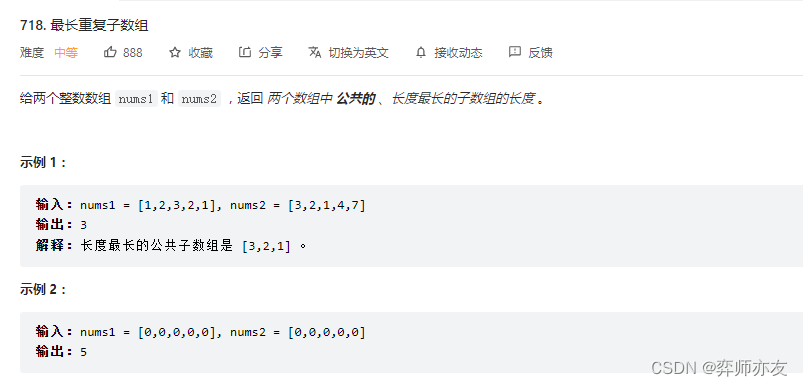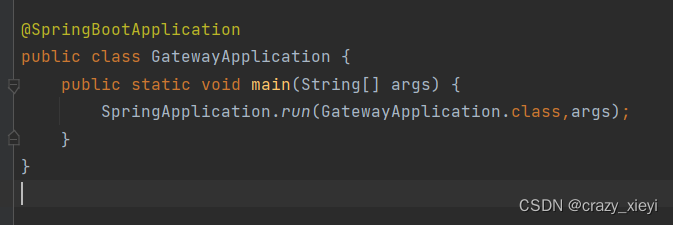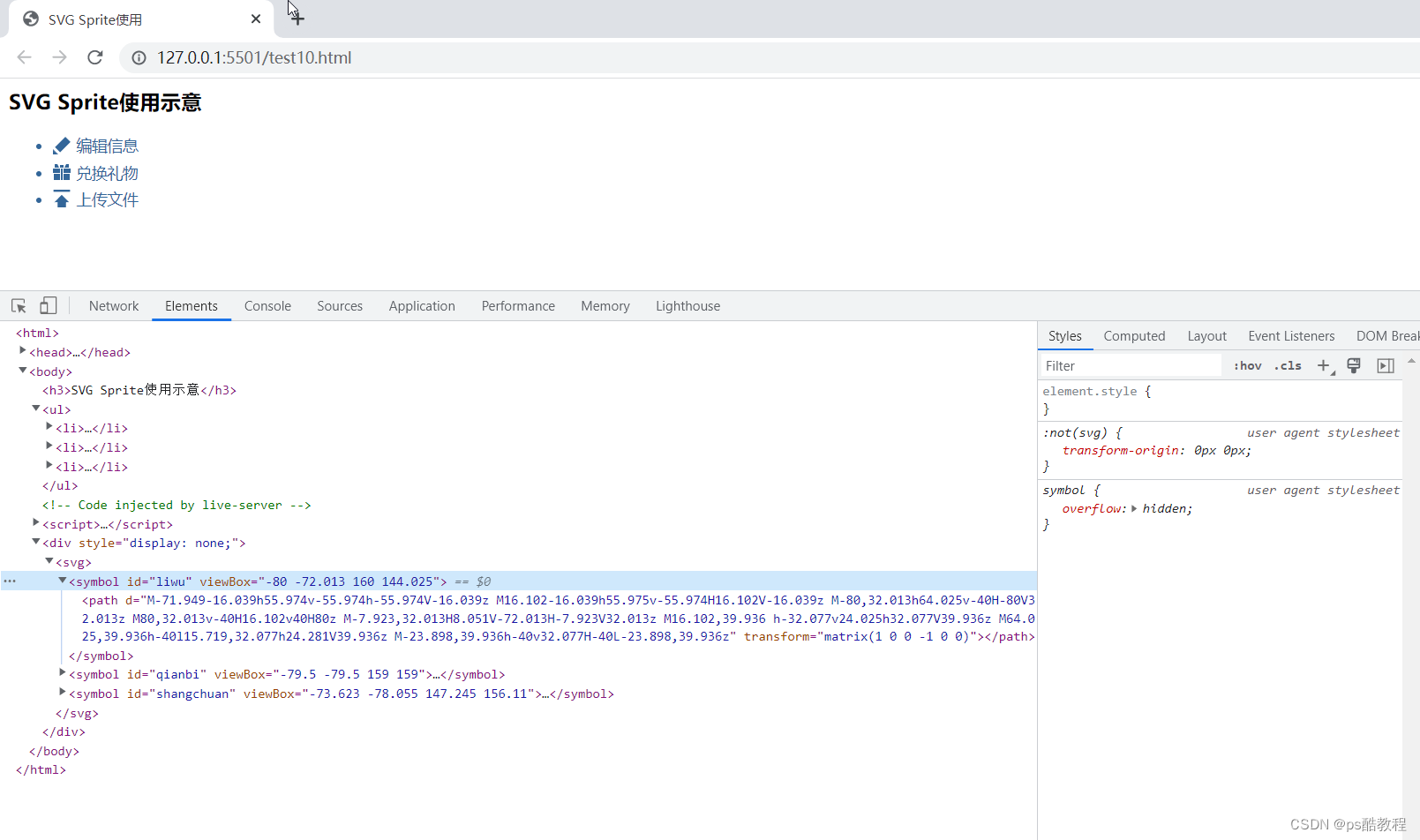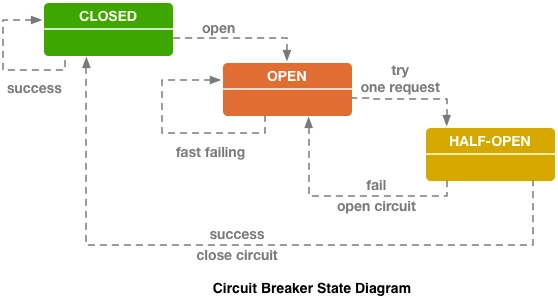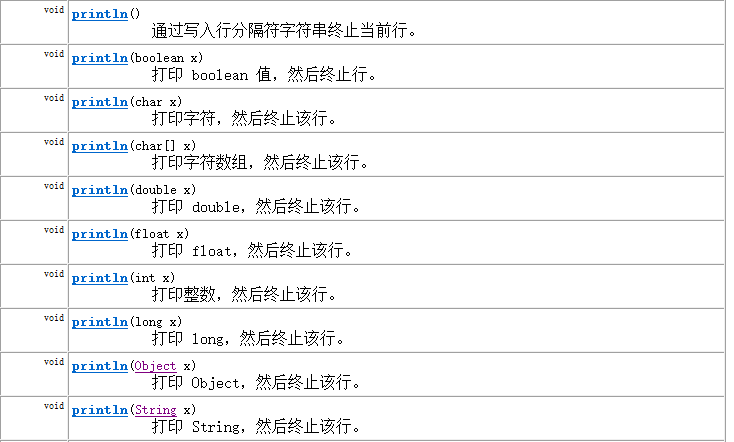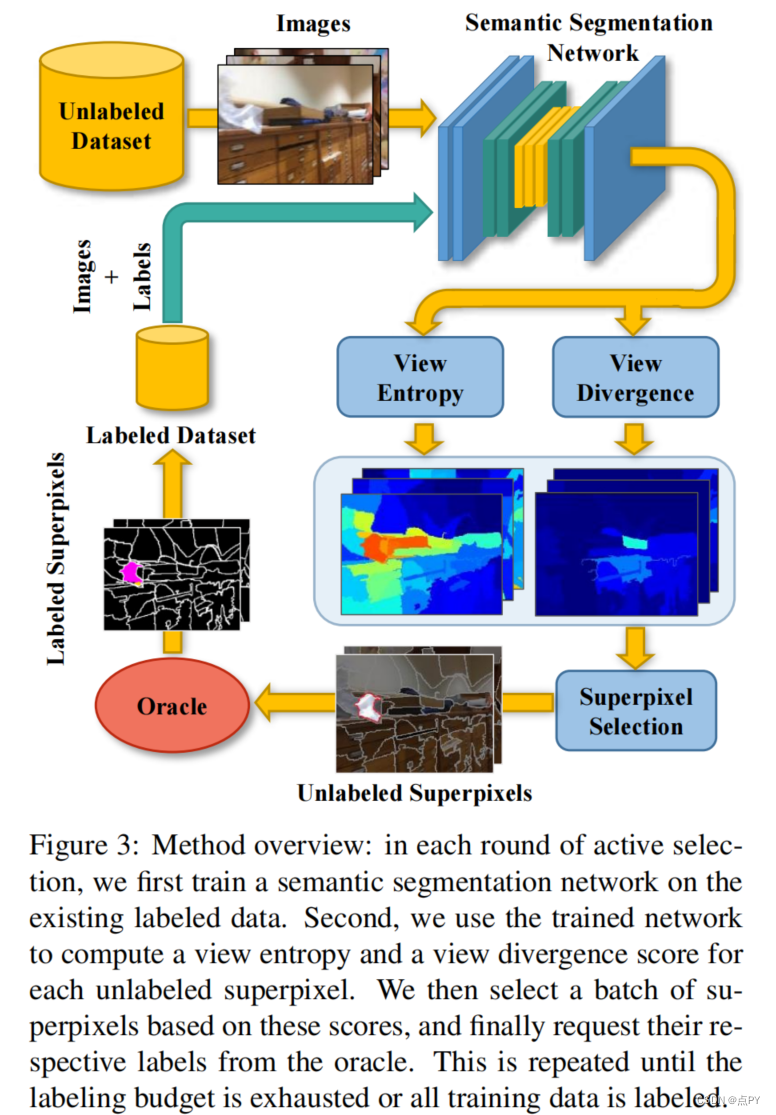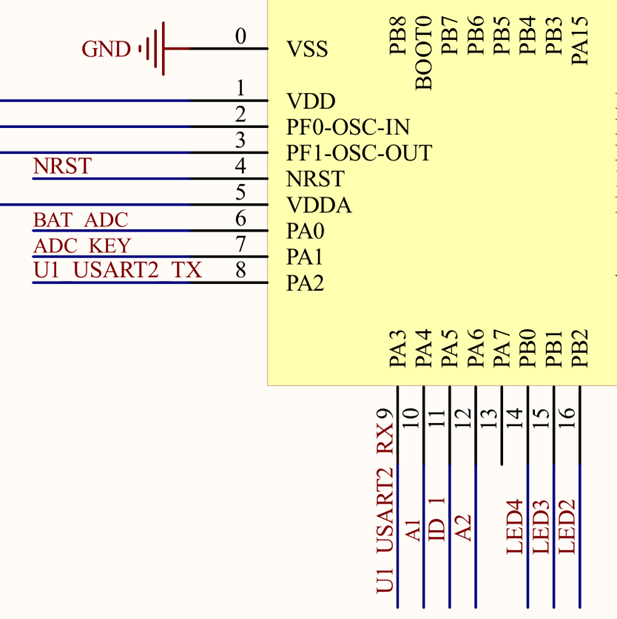seaborn从入门到精通03-绘图功能实现02-分类绘图Categorical plots
- 总结
- 参考
- 关系-分布-分类
- 分类绘图-Visualizing categorical data
- 图形级接口catplot--figure-level interface
- 导入库与查看tips和diamonds 数据
- 分类散点图
- 参考
- 分布散点图stripplot
- 分布密度散点图-swarmplot()
- 案例1-默认分类散点图-jitter抖动
- 案例2-分类散点图kind="swarm"
- 案例3-hue参数
- 案例4-横向分布
- 分类分布图
- 参考:
- 案例1-箱线图-Boxplots
- 案例2-箱线图boxplot带hue参数
- 案例3-箱线图boxplot带
- 案例4-更大的箱型图boxenplot
- 案例5-小提琴图Violinplots
- 案例6-小提琴图Violinplots参数bw和cut
- 案例7-小提琴图Violinplots参数splits
- 案例/-小提琴图Violinplots参数inner
- 案例8-小提琴图Violinplots参数整合swarmplot()或stripplot()
- 分类估计图
- 参考
- 案例1-条形图barplot
- 案例2-条形图barplot的置信区间
- 案例3-计数统计图countplot
- 案例4-计数统计图countplot参数edgecolor
- 案例5-点图pointplot
- 案例6-点图pointplot参数markers和linestyles
- 显示其他维度-Showing additional dimensions
总结
本文主要是seaborn从入门到精通系列第3篇,本文介绍了seaborn的绘图功能实现,本文是分类绘图,同时介绍了较好的参考文档置于博客前面,读者可以重点查看参考链接。本系列的目的是可以完整的完成seaborn从入门到精通。重点参考连接

参考
seaborn官方
seaborn官方介绍
seaborn可视化入门
【宝藏级】全网最全的Seaborn详细教程-数据分析必备手册(2万字总结)
Seaborn常见绘图总结
关系-分布-分类
relational “关系型”
distributional “分布型”
categorical “分类型”
分类绘图-Visualizing categorical data
In the relational plot tutorial we saw how to use different visual representations to show the relationship between multiple variables in a dataset. In the examples, we focused on cases where the main relationship was between two numerical variables. If one of the main variables is “categorical” (divided into discrete groups) it may be helpful to use a more specialized approach to visualization.
在关系图教程中,我们看到了如何使用不同的可视化表示来显示数据集中多个变量之间的关系。在示例中,我们关注的主要关系是两个数值变量之间的情况。如果其中一个主要变量是“分类的”(分为离散的组),那么使用更专业的可视化方法可能会有所帮助。
In seaborn, there are several different ways to visualize a relationship involving categorical data. Similar to the relationship between relplot() and either scatterplot() or lineplot(), there are two ways to make these plots. There are a number of axes-level functions for plotting categorical data in different ways and a figure-level interface, catplot(), that gives unified higher-level access to them.
在seaborn中,有几种不同的方法来可视化涉及分类数据的关系。类似于relplot()和scatterplot()或lineplot()之间的关系,有两种方法来创建这些图。有许多轴级函数用于以不同的方式绘制分类数据,还有一个图形级接口catplot(),用于提供对分类数据的统一高级访问。
It’s helpful to think of the different categorical plot kinds as belonging to three different families, which we’ll discuss in detail below. They are:
将不同的分类情节类型视为属于三个不同的家族是有帮助的,我们将在下面详细讨论。它们是:
Categorical scatterplots:(分类散点图)
stripplot() (with kind="strip"; the default) (分布散点图)
swarmplot() (with kind="swarm") (分布密度散点图)
Categorical distribution plots: (分类分布图)
boxplot() (with kind="box") (箱线图)
violinplot() (with kind="violin") (小提琴图)
boxenplot() (with kind="boxen") (为更大的数据集绘制增强的箱形图。)
Categorical estimate plots: (分类估计图)
pointplot() (with kind="point") (点图)
barplot() (with kind="bar") (条形图)
countplot() (with kind="count") (计数统计图)
These families represent the data using different levels of granularity. When deciding which to use, you’ll have to think about the question that you want to answer. The unified API makes it easy to switch between different kinds and see your data from several perspectives.
这些族表示使用不同粒度级别的数据。在决定使用哪种方法时,你必须考虑你想要回答的问题。统一的API可以方便地在不同类型之间切换,并从多个角度查看数据。
In this tutorial, we’ll mostly focus on the figure-level interface, catplot(). Remember that this function is a higher-level interface each of the functions above, so we’ll reference them when we show each kind of plot, keeping the more verbose kind-specific API documentation at hand.
在本教程中,我们将主要关注图形级接口catplot()。请记住,这个函数是上面每个函数的高级接口,因此我们将在显示每种类型的图表时引用它们,并保留更详细的特定于类型的API文档。
图形级接口catplot–figure-level interface
参考:http://seaborn.pydata.org/generated/seaborn.catplot.html#seaborn.catplot
seaborn.catplot(data=None, *, x=None, y=None, hue=None, row=None, col=None, col_wrap=None, estimator='mean', errorbar=('ci', 95),
n_boot=1000, units=None, seed=None, order=None, hue_order=None, row_order=None, col_order=None, height=5, aspect=1, kind='strip',
native_scale=False, formatter=None, orient=None, color=None, palette=None, hue_norm=None, legend='auto', legend_out=True,
sharex=True, sharey=True, margin_titles=False, facet_kws=None, ci='deprecated', **kwargs)
data:用于绘图的数据集。
x, y:指定分类变量和数值变量。
hue:指定另一个分类变量,相当于给绘图加上一维,不同颜色表示不同的分类。
row, col:指定用哪个变量分行或分列展示。
col_wrap:分列时展示的最大列数。
estimator:设定如何计算均值以及置信区间。
errorbar:设定误差线风格及置信水平。
n_boot:设定计算置信区间使用的bootstrap次数。
units:指定用于聚合的观测单位。
seed:设置随机数生成的种子。
order, hue_order, row_order, col_order:指定排序顺序。
height, aspect:设置图像的大小和比例。
kind:指定绘图类型,如’strip’, ‘swarm’, ‘box’, 'violin’等。
native_scale:设定原始数据是否进行标准化。
formatter:设定文本标签的格式。
orient:设置图像的方向。
color:指定所有元素的颜色。
palette:指定颜色调色板。
hue_norm:指定颜色标准化。
legend:设定是否显示图例。
legend_out:设定图例是否放在绘图外。
sharex, sharey:设定是否使用相同的x、y轴范围。
margin_titles:设定上边缘的标题是否显示。
facet_kws:可选的传递给 FacetGrid 的其他参数。
ci:设定计算置信区间的方法。
**kwargs:其他可选参数。
导入库与查看tips和diamonds 数据
import numpy as np
import pandas as pd
import matplotlib.pyplot as plt
import matplotlib as mpl
import seaborn as sns
sns.set_theme(style="darkgrid")
mpl.rcParams['font.sans-serif']=['SimHei']
mpl.rcParams['axes.unicode_minus']=False
tips = sns.load_dataset("tips",cache=True,data_home=r"./seaborn-data")
tips.head()
diamonds = sns.load_dataset("diamonds",cache=True,data_home=r"./seaborn-data")
print(diamonds.head())

titanic = sns.load_dataset("titanic",cache=True,data_home=r"./seaborn-data")
print(titanic.info())
print(titanic.head())
输出:
<class 'pandas.core.frame.DataFrame'>
RangeIndex: 891 entries, 0 to 890
Data columns (total 15 columns):
# Column Non-Null Count Dtype
--- ------ -------------- -----
0 survived 891 non-null int64
1 pclass 891 non-null int64
2 sex 891 non-null object
3 age 714 non-null float64
4 sibsp 891 non-null int64
5 parch 891 non-null int64
6 fare 891 non-null float64
7 embarked 889 non-null object
8 class 891 non-null category
9 who 891 non-null object
10 adult_male 891 non-null bool
11 deck 203 non-null category
12 embark_town 889 non-null object
13 alive 891 non-null object
14 alone 891 non-null bool
dtypes: bool(2), category(2), float64(2), int64(4), object(5)
memory usage: 80.7+ KB
None
survived pclass sex age sibsp parch ... who adult_male deck embark_town alive alone
0 0 3 male 22.0 1 0 ... man True NaN Southampton no False
1 1 1 female 38.0 1 0 ... woman False C Cherbourg yes False
2 1 3 female 26.0 0 0 ... woman False NaN Southampton yes True
3 1 1 female 35.0 1 0 ... woman False C Southampton yes False
4 0 3 male 35.0 0 0 ... man True NaN Southampton no True
分类散点图
Categorical scatterplots:(分类散点图)
stripplot() (with kind="strip"; the default) (分布散点图)
swarmplot() (with kind="swarm") (分布密度散点图)
参考
stripplot
swarmplot
分布散点图stripplot
参考:http://seaborn.pydata.org/generated/seaborn.stripplot.html#seaborn.stripplot
seaborn.stripplot(data=None, *, x=None, y=None, hue=None, order=None, hue_order=None, jitter=True, dodge=False, orient=None,
color=None, palette=None, size=5, edgecolor='gray', linewidth=0, hue_norm=None, native_scale=False, formatter=None, legend='auto',
ax=None, **kwargs)
data:用于绘图的数据集。
x, y:指定分类变量和数值变量。
hue:指定另一个分类变量,相当于给绘图加上一维,不同颜色表示不同的分类。
row, col:指定用哪个变量分行或分列展示。
col_wrap:分列时展示的最大列数。
estimator:设定如何计算均值以及置信区间。
errorbar:设定误差线风格及置信水平。
n_boot:设定计算置信区间使用的bootstrap次数。
units:指定用于聚合的观测单位。
seed:设置随机数生成的种子。
order, hue_order, row_order, col_order:指定排序顺序。
height, aspect:设置图像的大小和比例。
kind:指定绘图类型,如’strip’, ‘swarm’, ‘box’, 'violin’等。
native_scale:设定原始数据是否进行标准化。
formatter:设定文本标签的格式。
orient:设置图像的方向。
color:指定所有元素的颜色。
palette:指定颜色调色板。
hue_norm:指定颜色标准化。
legend:设定是否显示图例。
legend_out:设定图例是否放在绘图外。
sharex, sharey:设定是否使用相同的x、y轴范围。
margin_titles:设定上边缘的标题是否显示。
facet_kws:可选的传递给 FacetGrid 的其他参数。
ci:设定计算置信区间的方法。
**kwargs:其他可选参数。
分布密度散点图-swarmplot()
这个函数类似于stripplot(),但是对点进行了调整(只沿着分类轴),这样它们就不会重叠。这更好地表示了值的分布,但它不能很好地扩展到大量的观测。
seaborn.swarmplot(data=None, *, x=None, y=None, hue=None, order=None, hue_order=None, dodge=False, orient=None, color=None,
palette=None, size=5, edgecolor='gray', linewidth=0, hue_norm=None, native_scale=False, formatter=None, legend='auto',
warn_thresh=0.05, ax=None, **kwargs)
这个函数类似于stripplot(),但是调整了点(仅沿分类轴),使它们不重叠。这可以更好地表示值的分布,但它不能很好地扩展到大量的观测。这种类型的情节有时被称为“蜂群”。
案例1-默认分类散点图-jitter抖动
在catplot()中,数据的默认表示形式使用散点图。实际上在seaborn中有两种不同的分类散点图,第一种是stripplot(),stripplot()是catplot()中默认的“kind”,它使用的方法是用少量的随机“抖动jitter”来调整点在分类轴上的位置:
ax = sns.catplot(data=tips, x="day", y="total_bill")

jitter参数控制抖动的大小或完全禁用抖动:
ax = sns.catplot(data=tips, x="day", y="total_bill",jitter=False)
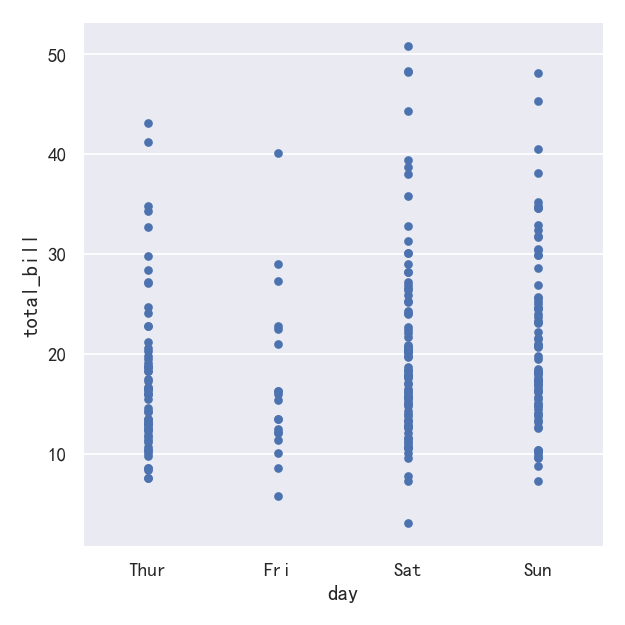
案例2-分类散点图kind=“swarm”
第二种方法是使用一种防止重叠的算法沿分类轴调整点。它可以更好地表示观测数据的分布,尽管它只适用于相对较小的数据集。这种图有时被称为“蜂群”,并通过在catplot()中设置kind="swarm"来激活swarmplot()在seaborn中绘制:
sns.catplot(data=tips, x="day", y="total_bill", kind="swarm")
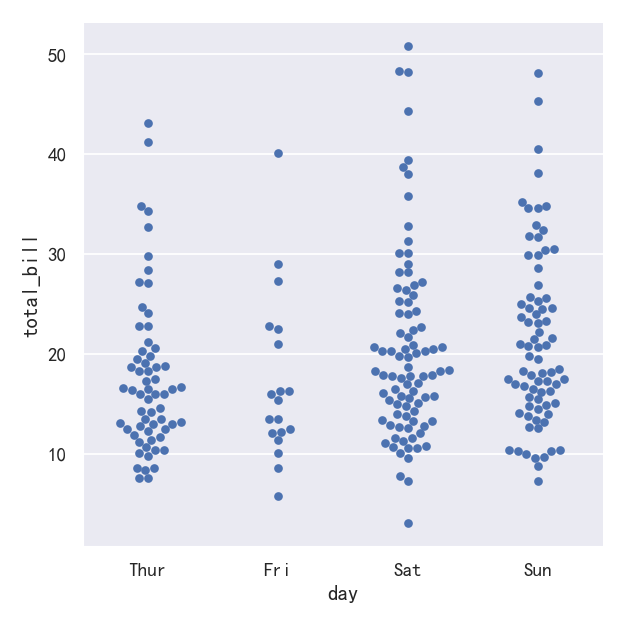
案例3-hue参数
Similar to the relational plots, it’s possible to add another dimension to a categorical plot by using a hue semantic. (The categorical plots do not currently support size or style semantics). Each different categorical plotting function handles the hue semantic differently. For the scatter plots, it is only necessary to change the color of the points:
与关系图类似,可以通过使用色调语义向分类图添加另一个维度。(分类图目前不支持大小或样式语义)。每个不同的分类绘图函数都以不同的方式处理色调语义。对于散点图,只需要改变点的颜色:
sns.catplot(data=tips, x="day", y="total_bill", hue="sex",kind="swarm")
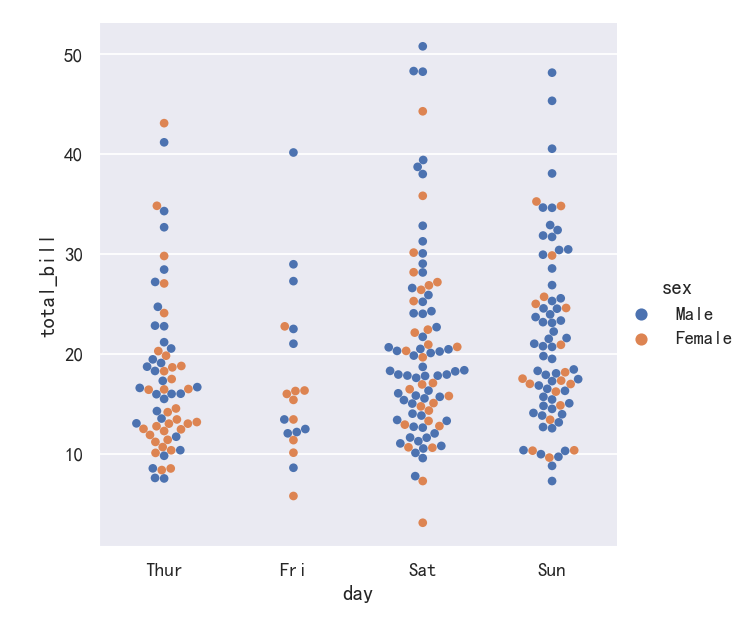
案例4-横向分布
We’ve referred to the idea of “categorical axis”. In these examples, that’s always corresponded to the horizontal axis. But it’s often helpful to put the categorical variable on the vertical axis (particularly when the category names are relatively long or there are many categories). To do this, swap the assignment of variables to axes:
我们已经提到了“分类轴”的概念。在这些例子中,它总是对应于横轴。但将类别变量放在垂直轴上通常是有帮助的(特别是当类别名称相对较长或有许多类别时)。要做到这一点,交换变量的分配到轴:
sns.catplot(data=tips, x="total_bill", y="day", hue="time", kind="swarm")
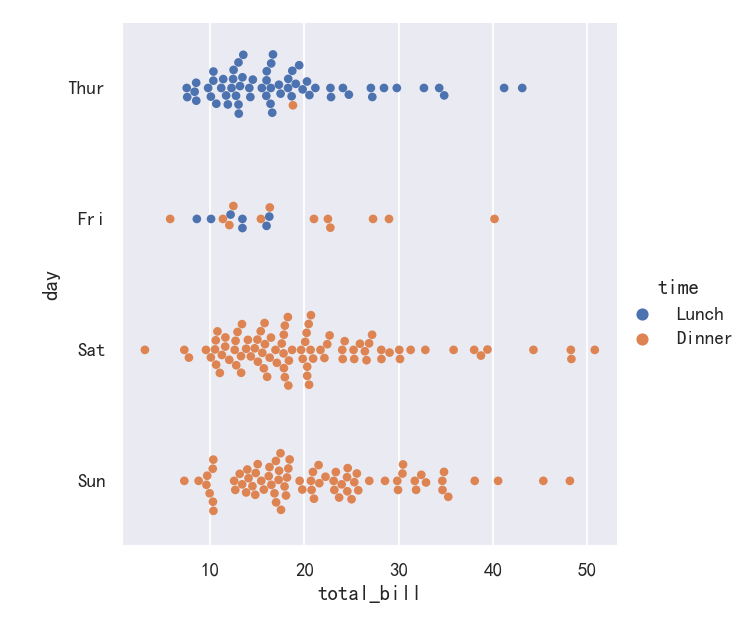
分类分布图
As the size of the dataset grows, categorical scatter plots become limited in the information they can provide about the distribution of values within each category. When this happens, there are several approaches for summarizing the distributional information in ways that facilitate easy comparisons across the category levels.
随着数据集规模的增长,分类散点图所能提供的关于每个类别内值分布的信息变得有限。当这种情况发生时,有几种方法可以总结分布信息,以便在类别级别之间进行简单的比较。
Categorical distribution plots: (分类分布图)
boxplot() (with kind="box") (箱线图)
violinplot() (with kind="violin") (小提琴图)
boxenplot() (with kind="boxen") (为更大的数据集绘制增强的箱形图。)
参考:
boxplot
boxenplot
violinplot
案例1-箱线图-Boxplots
The first is the familiar boxplot(). This kind of plot shows the three quartile values of the distribution along with extreme values. The “whiskers” extend to points that lie within 1.5 IQRs of the lower and upper quartile, and then observations that fall outside this range are displayed independently. This means that each value in the boxplot corresponds to an actual observation in the data.
第一个是我们熟悉的箱线图()。这种图显示了分布的三个四分位值和极值。“胡须”延伸到位于上下四分位数1.5 IQRs范围内的点,然后在此范围之外的观测结果将独立显示。这意味着箱线图中的每个值都对应于数据中的一个实际观测值。
sns.catplot(data=tips, x="day", y="total_bill", kind="box")
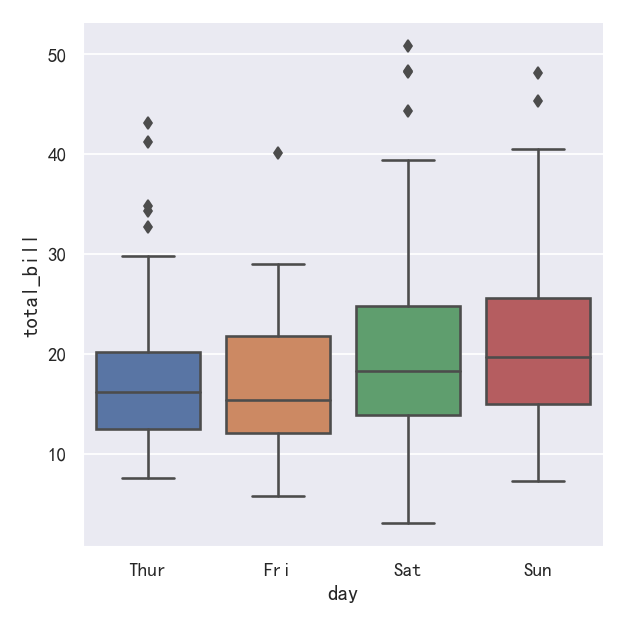
案例2-箱线图boxplot带hue参数
When adding a hue semantic, the box for each level of the semantic variable is moved along the categorical axis so they don’t overlap:
当添加色相语义时,语义变量的每一层的方框都沿着分类轴移动,这样它们就不会重叠:
sns.catplot(data=tips, x="day", y="total_bill",hue='smoker', kind="box")
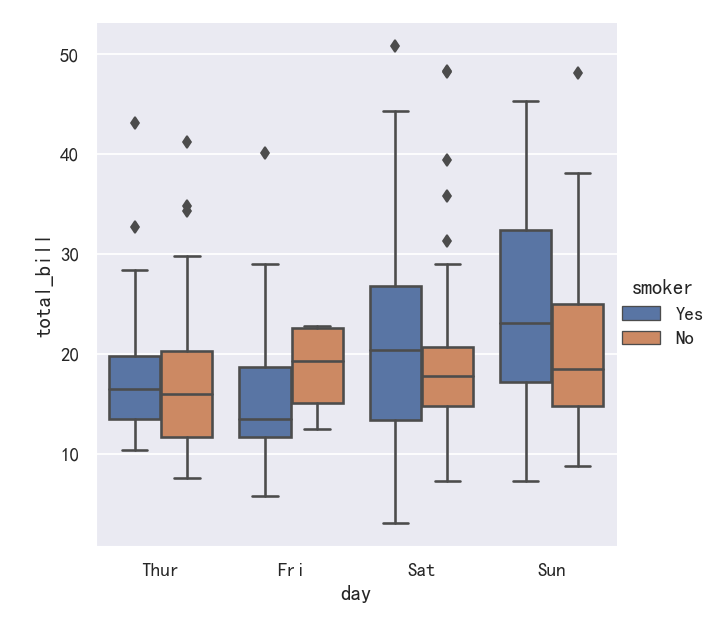
案例3-箱线图boxplot带
This behavior is called “dodging” and is turned on by default because it is assumed that the semantic variable is nested within the main categorical variable. If that’s not the case, you can disable the dodging:
这种行为称为“回避”,默认情况下是开启的,因为假定语义变量嵌套在主类别变量中。如果不是这样,你可以禁用闪避:
import copy
tips_copy = copy.deepcopy(tips)
tips_copy["weekend"] = tips_copy["day"].isin(["Sat", "Sun"])
sns.catplot(
data=tips_copy, x="day", y="total_bill", hue="weekend",
kind="box", dodge=False,
)
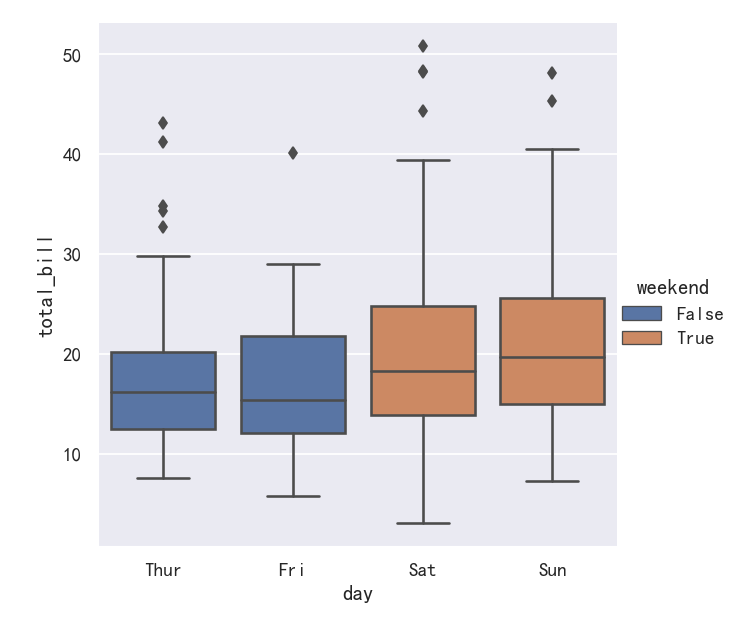
案例4-更大的箱型图boxenplot
A related function, boxenplot(), draws a plot that is similar to a box plot but optimized for showing more information about the shape of the distribution. It is best suited for larger datasets:
与此相关的函数boxenplot()绘制了一个类似于箱形图的图,但优化了显示关于分布形状的更多信息。它最适合大型数据集:
sns.catplot(
data=diamonds.sort_values("color"),
x="color", y="price", kind="boxen",
)
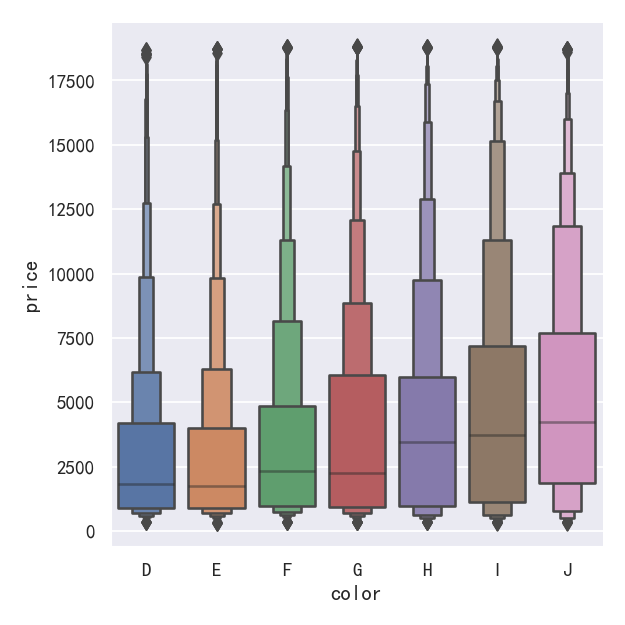
案例5-小提琴图Violinplots
A different approach is a violinplot(), which combines a boxplot with the kernel density estimation procedure described in the distributions tutorial:
另一种方法是violinplot(),它将箱线图与分布教程中描述的内核密度估计过程结合在一起:
sns.catplot(
data=tips, x="total_bill", y="day", hue="sex", kind="violin",
)
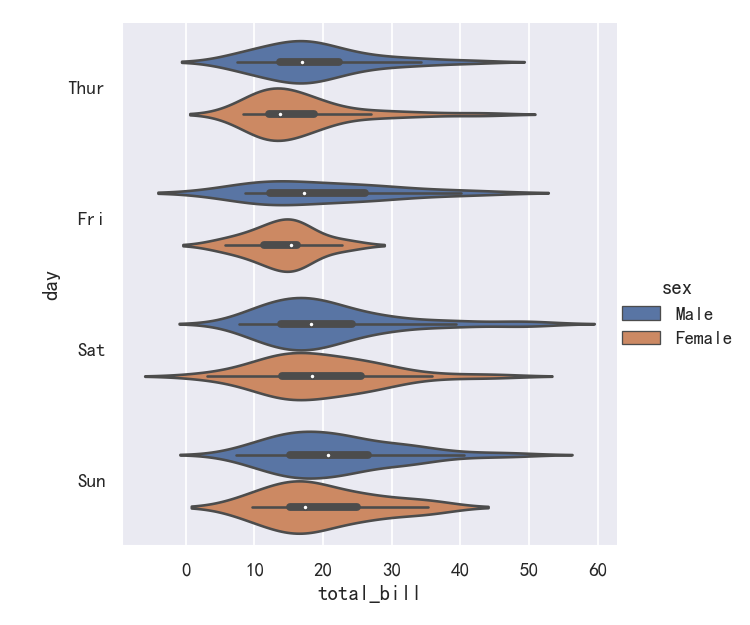
案例6-小提琴图Violinplots参数bw和cut
This approach uses the kernel density estimate to provide a richer description of the distribution of values. Additionally, the quartile and whisker values from the boxplot are shown inside the violin. The downside is that, because the violinplot uses a KDE, there are some other parameters that may need tweaking, adding some complexity relative to the straightforward boxplot:
这种方法使用核密度估计来提供更丰富的值分布描述。此外,箱线图中的四分位值和晶须值显示在小提琴内部。缺点是,由于violinplot使用KDE,有一些其他参数可能需要调整,相对于简单的箱线图增加了一些复杂性:
bw{‘scott’, ‘silverman’, float}, optional
Either the name of a reference rule or the scale factor to use when computing the kernel bandwidth. The actual kernel size will be determined by multiplying the scale factor by the standard deviation of the data within each bin.
引用规则的名称或计算内核带宽时使用的比例因子。实际的内核大小将通过将比例因子乘以每个bin中的数据的标准偏差来确定。
cut float, optional
Distance, in units of bandwidth size, to extend the density past the extreme datapoints. Set to 0 to limit the violin range within the range of the observed data (i.e., to have the same effect as trim=True in ggplot.
距离(以带宽大小为单位),以将密度扩展到极限数据点。设置为0将小提琴的范围限制在观察到的数据范围内(即,与ggplot中的trim=True具有相同的效果。
sns.catplot(
data=tips, x="total_bill", y="day", hue="sex",
kind="violin", bw=.15, cut=0,
)
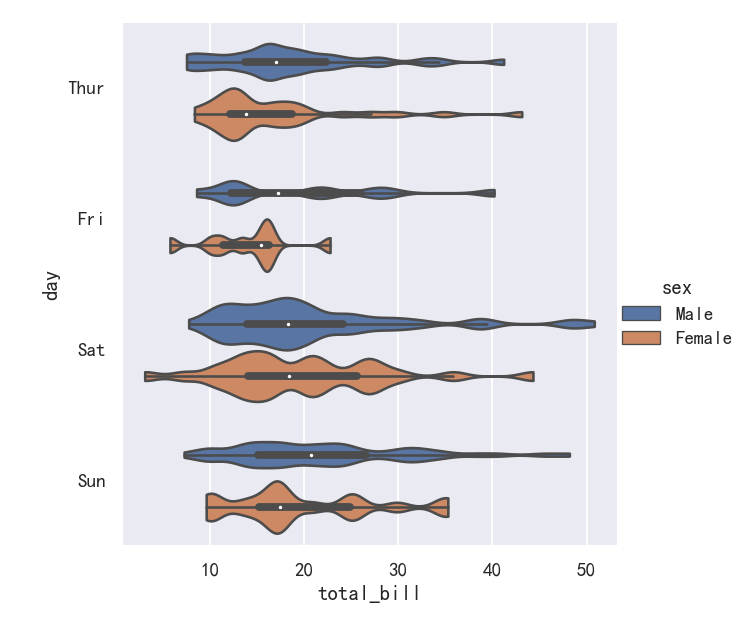
案例7-小提琴图Violinplots参数splits
It’s also possible to “split” the violins when the hue parameter has only two levels, which can allow for a more efficient use of space:
当色调参数只有两层时,也可以“分割”小提琴,这可以更有效地利用空间:
sns.catplot(
data=tips, x="day", y="total_bill", hue="sex",
kind="violin", split=True,
)
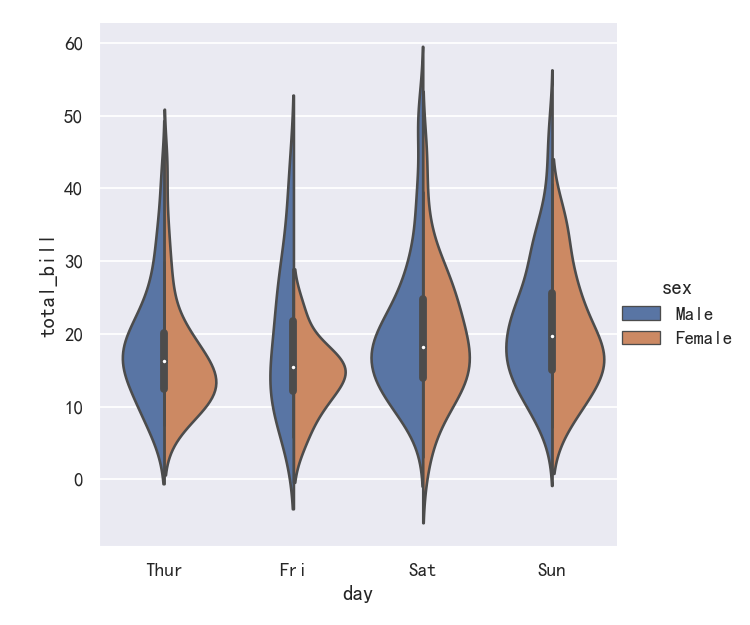
案例/-小提琴图Violinplots参数inner
Finally, there are several options for the plot that is drawn on the interior of the violins, including ways to show each individual observation instead of the summary boxplot values:
最后,在小提琴内部绘制的图有几个选项,包括显示每个单独的观察结果而不是总结箱线图值的方法
inner=“stick” “box” “point” “quart”
sns.catplot(
data=tips, x="day", y="total_bill", hue="sex",
kind="violin", inner="stick", split=True, palette="pastel",
)

案例8-小提琴图Violinplots参数整合swarmplot()或stripplot()
It can also be useful to combine swarmplot() or stripplot() with a box plot or violin plot to show each observation along with a summary of the distribution:
将swarmplot()或stripplot()与箱形图或小提琴图结合起来也很有用,以显示每个观察结果以及分布的摘要:
g = sns.catplot(data=tips, x="day", y="total_bill", kind="violin", inner=None)
sns.swarmplot(data=tips, x="day", y="total_bill", color="k", size=3, ax=g.ax)
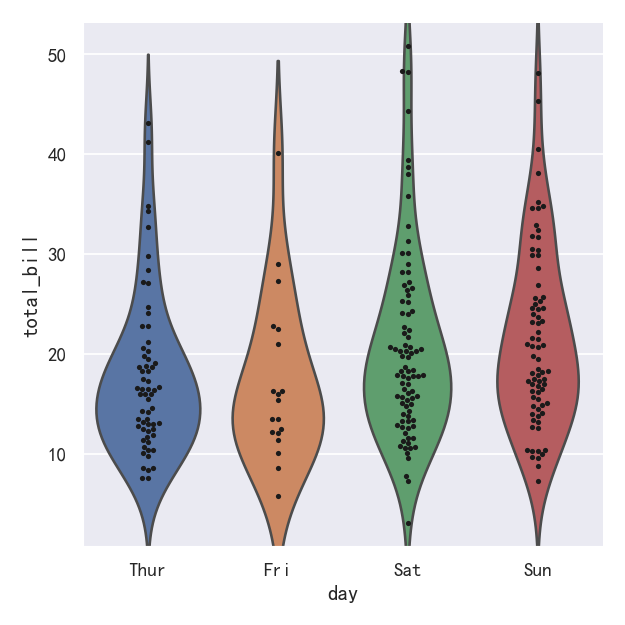
分类估计图
For other applications, rather than showing the distribution within each category, you might want to show an estimate of the central tendency of the values. Seaborn has two main ways to show this information. Importantly, the basic API for these functions is identical to that for the ones discussed above.
对于其他应用程序,与其显示每个类别内的分布,不如显示值的集中趋势的估计值。Seaborn有两种主要方式来显示这些信息。重要的是,这些函数的基本API与上面讨论的相同。
Categorical estimate plots: (分类估计图)
pointplot() (with kind="point") (点图)
barplot() (with kind="bar") (条形图)
countplot() (with kind="count") (计数统计图)
参考
pointplot
barplot
countplot
案例1-条形图barplot
A familiar style of plot that accomplishes this goal is a bar plot. In seaborn, the barplot() function operates on a full dataset and applies a function to obtain the estimate (taking the mean by default). When there are multiple observations in each category, it also uses bootstrapping to compute a confidence interval around the estimate, which is plotted using error bars:
实现这一目标的常见情节类型是条形图。在seaborn中,barplot()函数操作一个完整的数据集,并应用一个函数来获得估计值(默认取平均值)。当每个类别中有多个观测值时,它还使用自举来计算估计值周围的置信区间,该置信区间使用误差条绘制:
sns.catplot(data=titanic, x="sex", y="survived", hue="class", kind="bar")

案例2-条形图barplot的置信区间
The default error bars show 95% confidence intervals, but (starting in v0.12), it is possible to select from a number of other representations:
默认的错误条显示95%的置信区间,但是(从v0.12开始),可以从许多其他表示中选择:
sns.catplot(data=titanic, x="age", y="deck", errorbar=("pi", 95), kind="bar")
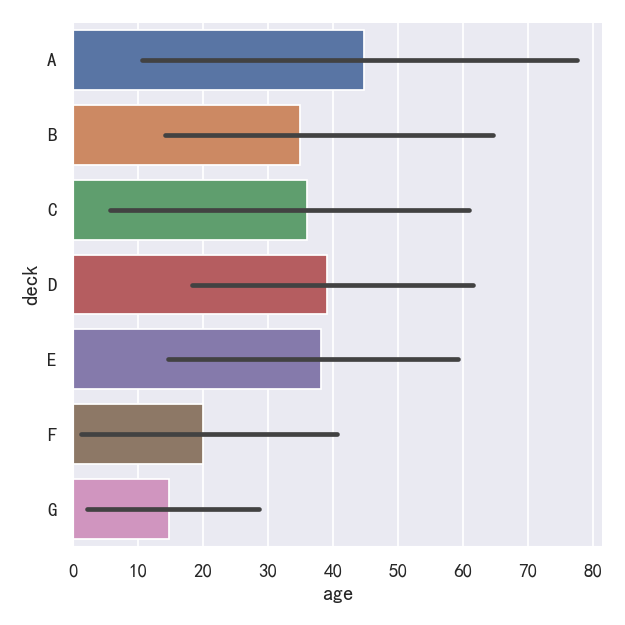
案例3-计数统计图countplot
A special case for the bar plot is when you want to show the number of observations in each category rather than computing a statistic for a second variable. This is similar to a histogram over a categorical, rather than quantitative, variable. In seaborn, it’s easy to do so with the countplot() function:
条形图的一个特殊情况是,当您希望显示每个类别中的观察数,而不是计算第二个变量的统计数据时。这类似于分类变量的直方图,而不是定量变量。在seaborn中,使用countplot()函数很容易做到这一点:
sns.catplot(data=titanic, x="deck", kind="count", palette="ch:.25")
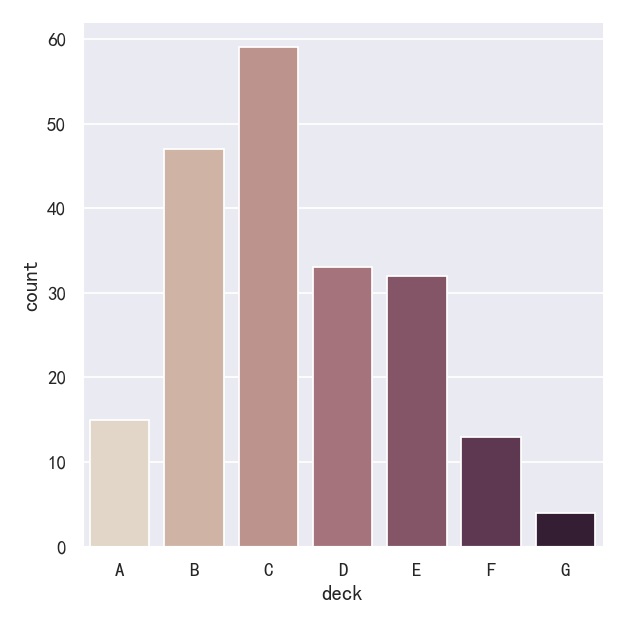
案例4-计数统计图countplot参数edgecolor
Both barplot() and countplot() can be invoked with all of the options discussed above, along with others that are demonstrated in the detailed documentation for each function:
barplot()和countplot()都可以用上面讨论的所有选项调用,以及在每个函数的详细文档中演示的其他选项:
sns.catplot(
data=titanic, y="deck", hue="class", kind="count",
palette="pastel", edgecolor=".6",
)

案例5-点图pointplot
An alternative style for visualizing the same information is offered by the pointplot() function. This function also encodes the value of the estimate with height on the other axis, but rather than showing a full bar, it plots the point estimate and confidence interval. Additionally, pointplot() connects points from the same hue category. This makes it easy to see how the main relationship is changing as a function of the hue semantic, because your eyes are quite good at picking up on differences of slopes:
pointplot()函数提供了可视化相同信息的另一种样式。该函数还在另一个轴上对高度的估计值进行编码,但它不是显示完整的条,而是绘制点估计值和置信区间。此外,pointplot()连接来自相同色调类别的点。这使得我们很容易看到主要关系是如何随着色调语义的变化而变化的,因为你的眼睛非常擅长捕捉斜率的差异:
sns.catplot(data=titanic, x="sex", y="survived", hue="class", kind="point")
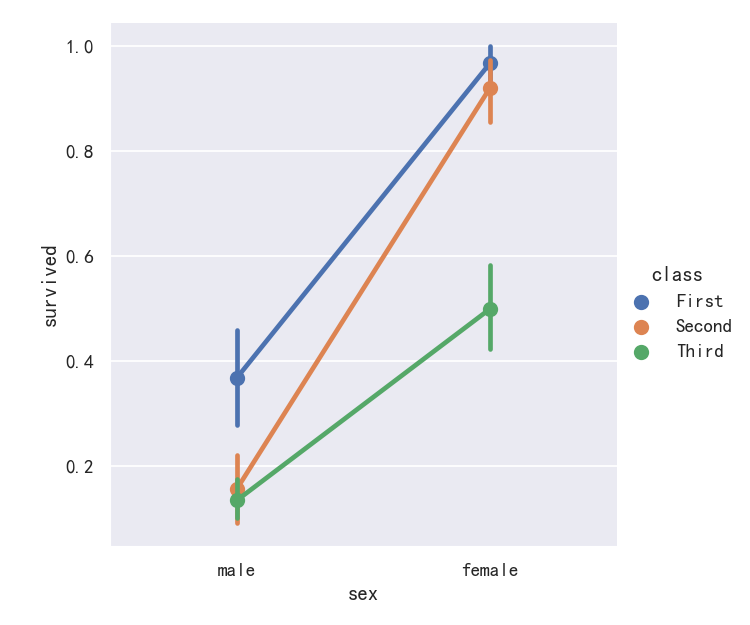
案例6-点图pointplot参数markers和linestyles
While the categorical functions lack the style semantic of the relational functions, it can still be a good idea to vary the marker and/or linestyle along with the hue to make figures that are maximally accessible and reproduce well in black and white:
虽然分类函数缺乏关系函数的风格语义,但随着色调变化标记和/或线条风格仍然是一个好主意,以使图形最大限度地可访问并在黑白中再现:
sns.catplot(
data=titanic, x="class", y="survived", hue="sex",
palette={"male": "g", "female": "m"},
markers=["^", "o"], linestyles=["-", "--"],
kind="point"
)
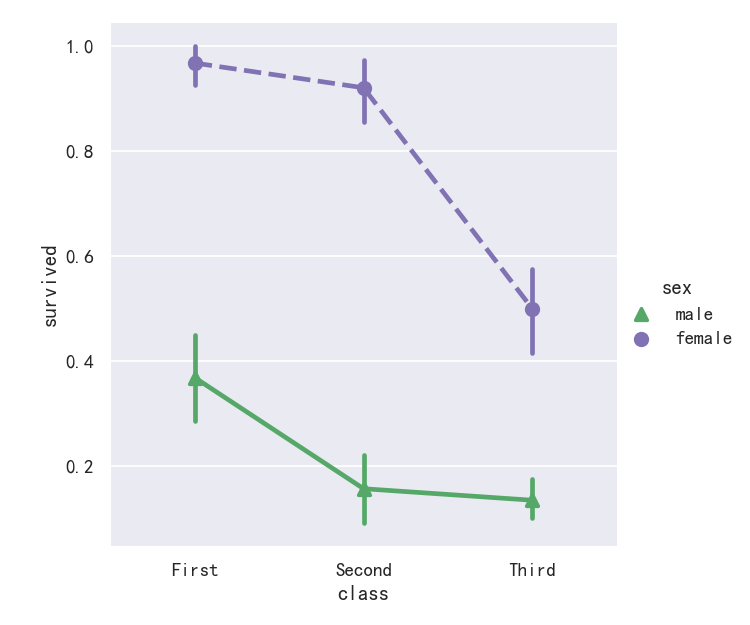
显示其他维度-Showing additional dimensions
Just like relplot(), the fact that catplot() is built on a FacetGrid means that it is easy to add faceting variables to visualize higher-dimensional relationships:
就像relplot()一样,事实上catplot()是在FacetGrid上构建的,这意味着很容易添加faceting变量来可视化高维关系:
sns.catplot(
data=tips, x="day", y="total_bill", hue="smoker",
kind="swarm", col="time", aspect=.7,
)
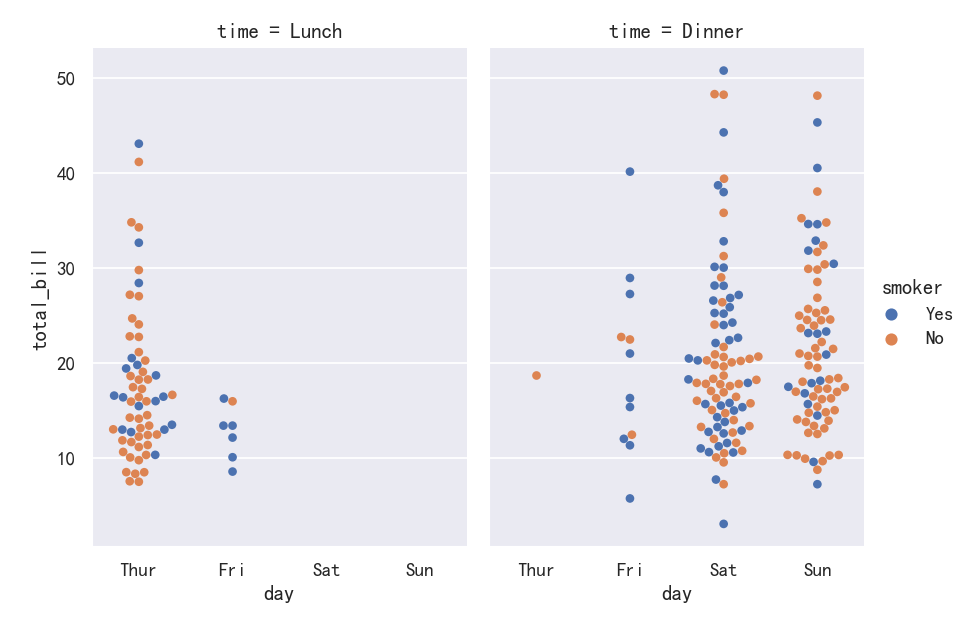
For further customization of the plot, you can use the methods on the FacetGrid object that it returns:
为了进一步定制绘图,您可以使用它返回的FacetGrid对象上的方法:
g = sns.catplot(
data=titanic,
x="fare", y="embark_town", row="class",
kind="box", orient="h",
sharex=False, margin_titles=True,
height=1.5, aspect=4,
)
g.set(xlabel="Fare", ylabel="")
g.set_titles(row_template="{row_name} class")
for ax in g.axes.flat:
ax.xaxis.set_major_formatter('${x:.0f}')
